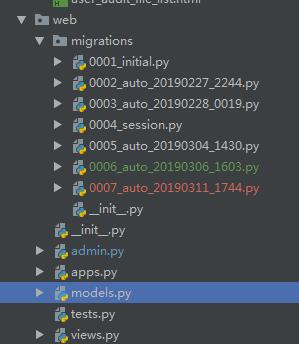您好,登錄后才能下訂單哦!
您好,登錄后才能下訂單哦!
怎么在django中利用migrations遷移文件?針對這個問題,這篇文章詳細介紹了相對應的分析和解答,希望可以幫助更多想解決這個問題的小伙伴找到更簡單易行的方法。
修改完models.py后,先在Terminal下執行命令
python manage.py makemigrations
這是僅僅是生成遷移記錄,執行過后,數據庫中的表并未發生變化。若是models發生改變,但是執行以上命令,顯示的是
No changes detected
則需要執行
python manage.py makemigrations + 你所改變的models.py所在的目錄
然后,要想表結構發生變化,還要執行以下命令
python manage.py migrate
執行完畢后,數據庫中的表結構已經改變
補充知識:django使用migrations遷移版本和數據庫中報錯解決方案
回滾django的migration:
https://stackoverflow.com/questions/32123477/django-revert-last-migration
I've made a migration that added a new table and want to revert it and delete the migration, without creating a new migration. How do I do it? Is there a command to revert last migration and then I can simply delete the migration file? You can revert by migrating to the previous migration. For example, if your last two migrations are: 0010_previous_migration 0011_migration_to_revert Then you would do: ./manage.py migrate my_app 0010_previous_migration You can then delete migration 0011_migration_to_revert. If you're using Django 1.8+, you can show the names of all the migrations with ./manage.py showmigrations my_app To reverse all migrations for an app, you can run: ./manage.py migrate my_app zero
1、到數據庫表django_migrations中查看app中看看app列

2、到項目對應的app模塊中打開migrations文件查看生成的文件與數據庫app列中的是不是一樣

3.找到哪里不一致的文件,然后使用python manage.py --fake [版本名字],將這個版本標記為已經映射
如果還是報錯就按照下面執行
1、刪除指定app下migrations和數據庫表django_migrations中和這個app相關的版本號,
2、將模型中的字段和數據庫中的字段保持一致,再使用命令python manage.py makemigrations重新生成一個初始化的遷移腳本。
3、再使用命令python manage.py makemigrations --fake-initial來將這個初始化的遷移腳本標記為已經映射。之后再修改就沒有問題了。
更多關于遷移腳本的。請查看官方文檔:https://docs.djangoproject.com/en/2.0/topics/migrations/
makemigrations和migrate時django都做了什么?
makemigrations:
執行makemigrations時檢測models文件變化,在migrations文件夾中生成變更的sql的py文件
migrate:檢測django_migrations表,遷移過的表會記錄在其中并不再執行migrate,未找到執行記錄則進行migrate
不要隨意刪除django項目目錄下的 migrations文件夾,里面會記錄models文件每次makemigrations操作,誤刪后,makemigrations會重新生成
#執行python manage.py makemigrations命令時報錯問題及解決辦法:
在修改了models.py后,有些用戶會喜歡用python manage.py makemigrations生成對應的py代碼。
但有時執行python manage.py makemigrations命令(也可能人比較皮,把migrations文件夾給刪了),會提示"No changes detected." 可能有用的解決方式如下:
先 python manage.py makemigrations --empty yourappname 生成一個空的initial.py
再 python manage.py makemigrations 生成原先的model對應的migration file
django-關于manage.py migrate無效的問題
問題描述:
已有的model,修改之后,想重新建模,于是將migrations文件夾中除__init__.py之外其他文件都刪掉,再次執行以下步驟python manage.py makemigrations確認成功,執行python manage.py migrate,提示No migrations to apply. 表示一臉懵逼。再次修改,指定表名,再次嘗試,發現問題依舊,表示二臉懵逼
排查過程
python manage.py dbshell 進到數據庫里面,查看是否表已存在
結果:表不存在
檢查migrations文件
結果:文件沒問題
百度 google 各種搜,亂投醫,各種嘗試
解決方案
python manage.py dbshell 進到數據庫中,執行delete from django_migrations where app='your_appname';
python manage.py makemigrations(若migrations文件未刪除,可不執行這一步)
python manage.py migrate 好啦,大功告成
原因分析
查看django_migrations表結構
建表語句:
CREATE TABLE "django_migrations" ("id" integer NOT NULL PRIMARY KEY AUTOINCREMENT, "app" varchar(255) NOT NULL, "name" varchar(255) NOT NULL, "applied" datetime NOT NULL);
原因
造成多次應用migrations失敗的原因是,當前model是修改過的,原來的migrations已經被我刪除,但是,重新生成的migrations使用遞增整數記名,所以,在django_migrations表中0001,0002等前面幾個數字的文件都已被記錄,在Django看來,被記錄了就相當于已應用,所以,會出現剛開始的No migrations to apply.
避免方案
有強迫癥刪除migrations文件的同學(比如我),請同時到數據庫中刪除相應記錄
沒有強迫癥的同學,可以繼續生成新的migrations,舊的就不必理會了
題外話
執行python manage.py migrate之后,可以使用python manage.py sqlmigrate appname migrations_num(例如python manage.py sqlmigrate user 0002)查看當前migrations文件對應的sql語句。
另外,在使用上述命令查看0002文件的sql語句時發現,django會新建一個表user_new,然后插入user表中的數據,再把user表刪掉,再把user_new重命名為user。所以,修改model的時候,不必擔心原有數據會丟失。
臨時解決:
在models中添加了一個model,makemigrations成功后,如果migrate提示no apply --》查看django——migrations是否有對應model的name記錄,如果沒有記錄 --》刪除model,再次makemigrations、migrate(提示無表,數據庫中手動創建對應表名)--》再添加model,再次makemigrations、migrate即可
關于怎么在django中利用migrations遷移文件問題的解答就分享到這里了,希望以上內容可以對大家有一定的幫助,如果你還有很多疑惑沒有解開,可以關注億速云行業資訊頻道了解更多相關知識。
免責聲明:本站發布的內容(圖片、視頻和文字)以原創、轉載和分享為主,文章觀點不代表本網站立場,如果涉及侵權請聯系站長郵箱:is@yisu.com進行舉報,并提供相關證據,一經查實,將立刻刪除涉嫌侵權內容。